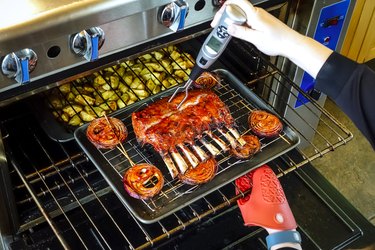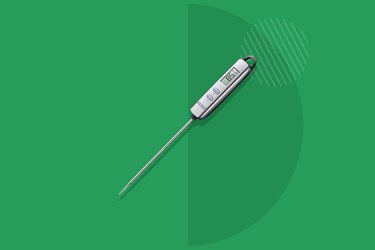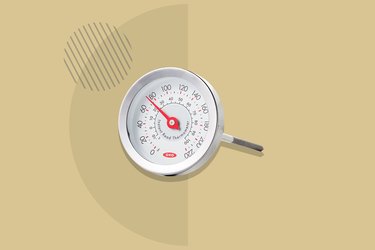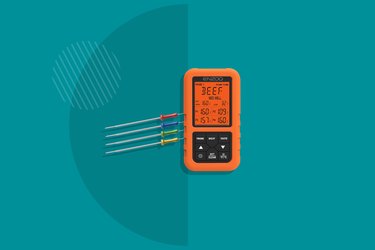
If you savor the scent of freshly grilled meat on a summer day, or if your go-to meal is a perfectly baked salmon fillet, you likely do your fair share of cooking meat.
But even if you're a seasoned home chef, it's important to take key steps to reduce your risk of foodborne illness, which can result in nausea, vomiting and diarrhea around four to 48 hours after you eat the food, per the University of Minnesota Extension.
Video of the Day
Video of the Day
Remember, even if you think you can eyeball a "done" steak or simply cook a chicken until the juices run clear, you can't see, smell or taste harmful bacteria that can make you sick, per the USDA.
"Many pathogens, such as E. coli or salmonella, are destroyed at certain temperatures in food," says Kara Lynch, RD, a food safety educator at Michigan State University Extension.
"We often hear to cook meat to a certain color or until juices run clear, but there's really no way of knowing it's at the proper temperature unless you actually take the temperature."
There are four key guidelines to keep food safe while preparing it, per the USDA:
- Wash your hands and surfaces often.
- Keep raw meat separated from other foods.
- Cook to the proper temperature.
- Chill food promptly and don't leave it sitting out.
Three out of four of these strategies are pretty self-explanatory, but what does "cook to the proper temperature" really mean? That's where a meat thermometer comes in handy.
How to Use a Meat Thermometer
Using a food thermometer is the only sure way to know you've cooked meat, fish and poultry to a minimum internal temperature that destroys any harmful microorganisms in the food, per the USDA.
When using a meat thermometer, insert it into the thickest part of the meat. Avoid touching bones and fat in the meat or the pan underneath it with the thermometer probe.
If you're measuring the temperature of a thin food like a hamburger patty or chicken breast, it's best to use digital food thermometers, which typically measure temperature with the tip of their probes.
If you're using a dial (analog) food thermometer, which has a larger sensing area, insert the probe into the side of the food so that the entire sensing area — usually 2 to 3 inches — is positioned all the way through to the center of the food, per the USDA.
"Take the temperature in at least two spots," says Lynch. "Depending on how big the piece of meat is, you might need more. If it's a large roast, you would probably want to take the temperature in at least three spots."
If you're cooking multiple pieces of meat at once, it's important to check the temperature of each one, not just the largest piece. For thin pieces of meat like fish, it may be helpful to stack them so the thermometer doesn't touch the pan as you're taking the temperature, Lynch says.
Different types of proteins require different internal temps. Make sure to check the chart below to ensure your dinner is cooked correctly.
Safe Minimum Cooking Temperatures
Food | Type | Internal Temperature |
|---|---|---|
Ground meat and meat mixtures | Beef, pork, veal and lamb | 160°F |
Ground meat and meat mixtures | Turkey, chicken | 165°F |
Fresh beef, veal, lamb | Steaks, roasts and chops Rest time: 3 mins. | 145°F |
Poultry | All poultry (breasts, whole bird, legs, thighs, wings, ground poultry, giblets and stuffing) | 165°F |
Pork and ham | Fresh pork, including fresh ham Rest time: 3 mins. | 145°F |
Pork and ham | Precooked ham (to reheat); reheat cooked hams packaged in USDA-inspected plants to 140°F | 165°F |
Leftovers and casseroles | All types of leftovers and casseroles | 165°F |
Seafood | Fish with fins | 145°F or cook until flesh is opaque and separates easily with a fork |
Seafood | Shrimp, lobster, crab and scallops | Cook until flesh is pearly or white, and opaque |
Seafood | Clams, oysters and mussels | Cook until shells open during cooking |
Different Types of Meat Thermometers
When choosing from a wide variety of meat thermometers, pick one that works best for your cooking needs — and be sure to use it every time you prepare meat.
Here are common types of thermometers you might encounter, per the Academy of Nutrition and Dietetics:
- Dial oven-safe thermometers: These can remain in place while your food cooks, but they're not ideal for thin foods. To use properly, insert the thermometer 2 to 2 1/2 inches into the thickest part of the meat (wait 1 to 2 minutes before reading). This thermometer is best for roasts, casseroles and soups.
- Dial instant-read thermometers: To read the temperature, place the stem about 2 to 2 1/2 inches deep in the thickest part of the meat and wait 15 to 20 seconds. This thermometer is best used in roasts, casseroles, soups or inserted into thin dishes from the side.
- Digital instant-read thermometers: These are good for both thin and thick foods (including shallow-tray frozen dinners). Insert the stem of the thermometer about a 1/2 inch deep into the meat, and read the temperature after 10 seconds.
- Pop-up thermometers: You might find these already in poultry you buy. Although these thermometers are designed to pop up when a food reaches its safe temperature, it's important to always verify with a conventional thermometer.
- Thermometer-fork combination: These can come in handy for grilling. Place at least a 1/4 inch deep in the thickest part of the meat, making sure the fork's sensor is inserted. This type of thermometer tends to read in 2 to 10 seconds.
Tip
It may be tempting to skip the manufacturer's instructions when you buy a new thermometer, but it’s worth giving them a read.
The instructions include important info, such as how far to insert a thermometer into a piece of meat for an accurate reading and how to calibrate your thermometer to ensure its reading stays accurate.
For products including raw beef, pork, lamb, veal steaks, chops and roasts, the Academy of Nutrition and Dietetics recommends using the food thermometer before removing the food from its heat source.
Allow meat to rest for at least three minutes before cutting or eating it for safety and quality. Use hot, soapy water to clean your thermometer after each use to avoid cross-contamination.
The 4 Best Meat Thermometers
When shopping for a meat thermometer, it's most important to find one you'll use regularly and that provides an accurate reading.
Here are four of the top-reviewed thermometers, from a basic analog tool to an app-connected smart thermometer, available at a range of price points.
1. Digital Instant-Read Meat Thermometer
If you prefer a digital meat thermometer, this one will become a go-to tool in your kitchen. Its 4.45-inch probe reads the temperature in 5 seconds or less.
That said, this thermometer is not designed to be left in place as your meat cooks, so you'll need to remove it after each temperature reading.
Easy to clean and reliable, this thermometer has positive reviews as a high-quality buy for its price point by Amazon reviewers. Use it for barbecue and smoked meat, steak, beef, turkey, chicken, fish and more.
Buy it: Amazon.com; Price: $7.99
2. OXO Instant-Read Thermometer
This is a good option for a no-fuss, analog thermometer. Amazon reviewers note that this instant-read thermometer features large numbers that are easy to read, and that it's a simple tool to use and clean.
Another handy feature: The probe is shaded, so you know exactly how far to insert it into the meat for an accurate reading. Meanwhile, the cover includes chef-recommended and USDA-recommended temperatures for various types of meat including poultry, beef, lamb, pork and ground meat.
Buy it: Amazon.com; Price: $12
3. ENZOO Wireless Meat Thermometer
This meat thermometer comes with four probes that allow you to monitor multiple temperatures at once. You can use this for various types of meat, or to simultaneously measure four spots on one large piece of meat.
The thermometer connects to a receiver that you can carry up to 500 feet away without losing range. With a large digital display, the device has USDA-approved preset temperatures for 11 types of meat.
The probes can remain in your meat as it cooks, and feature wires capable of withstanding heat of up to 716 degrees Fahrenheit.
Buy it: Amazon.com; Price: $44.99
4. MEATER+ Wireless Meat Thermometer
Touted as the first wireless "smart" meat thermometer, this sleek device connects to your smartphone and allows you to monitor meat as it cooks.
Simply insert the probe into the meat, select what you're cooking and how well done you'd like it on the MEATER app, and follow the instructions to cook. The MEATER app will estimate your cook time, even considering "carry over" cooking for the best results.
This particular model comes with a wireless charging dock that doubles as a Bluetooth repeater. That creates a wireless range of up to 165 feet, so you don't have to hover over your roast as it cooks. The thermometer also has two sensors that can measure both internal meat temperature and ambient temperature.
Amazon reviewers remark that although it's a pricier option, the MEATER+ thermometer is worth the investment for meat lovers.
Buy it: Amazon.com; Price: $99
- United States Department of Agriculture: "Safe Minimum Internal Temperature Chart"
- University of Minnesota Extension: "Safe meat handling and cooking temperatures"
- United States Department of Agriculture: "Kitchen Thermometers"
- United States Department of Agriculture: " 5 Proper Thermometer Placement"
- U.S. Department of Health & Human Services: "Safe Minimum Cooking Temperatures Charts"
- Academy of Nutrition and Dietetics: "A Short Guide to Food Thermometers"
- USDA: "Kitchen Thermometers"




